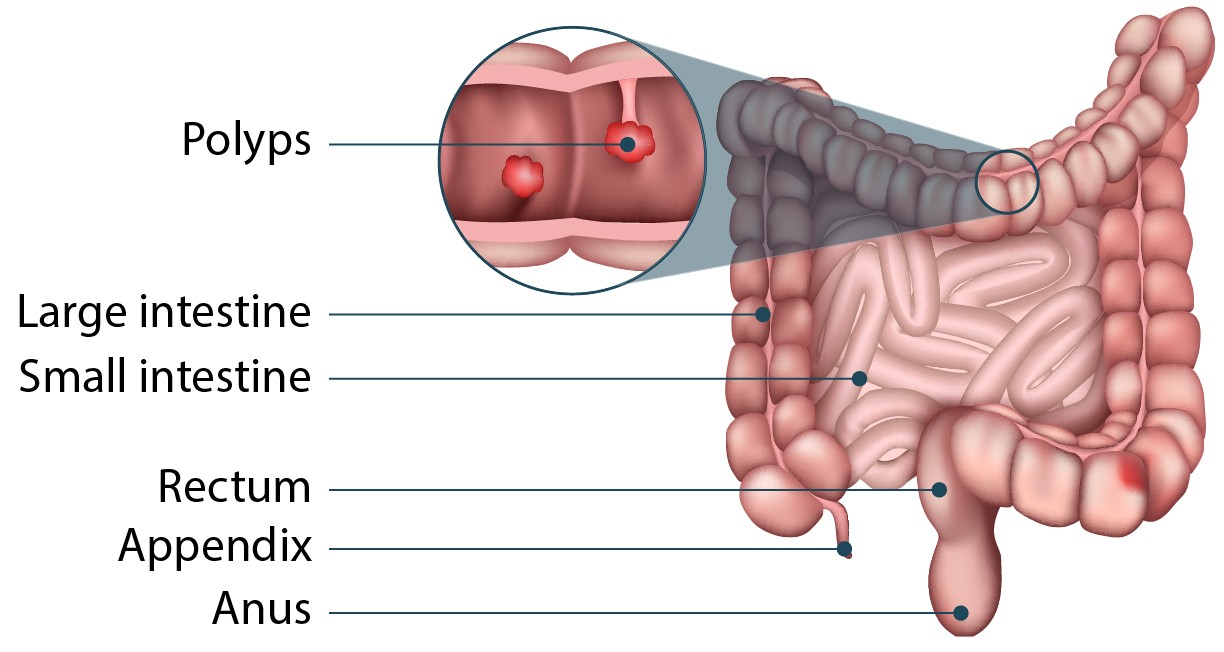Polyps are abnormal tissue growths that can occur in various parts of the body. At WHAT.EDU.VN, we provide comprehensive information to help you understand polyps, their potential risks, and available treatment options. Early detection and management are key to preventing complications, and we’re here to guide you through the process. Polyps are growths, abnormal cells, and precancerous growths.
1. What Exactly Are Polyps?
Polyps are abnormal growths of tissue that project from the mucous membrane in the body. They can occur in various organs, including the colon, nose, throat, uterus, and stomach. While most polyps are benign (non-cancerous), some can be precancerous or cancerous. Therefore, it’s essential to understand what polyps are, where they can occur, and what to do if you are diagnosed with them.
- Benign Polyps: These are non-cancerous growths that generally do not pose an immediate threat to health.
- Precancerous Polyps: These polyps have the potential to develop into cancer over time. Regular screening and removal are crucial to prevent cancer development.
- Cancerous Polyps: These are malignant polyps that can spread to other parts of the body. Early detection and treatment are vital for improving outcomes.
 Intestinal polyps, abnormal tissue growths
Intestinal polyps, abnormal tissue growths
2. Where Can Polyps Develop in the Body?
Polyps can develop in various locations throughout the body. Here’s a rundown of some common sites:
- Colon and Rectum (Colorectal Polyps): These are among the most common types of polyps and are often detected during colonoscopies. They can be either benign or precancerous.
- Nose (Nasal Polyps): Nasal polyps are soft, painless growths that develop on the lining of the nasal passages or sinuses.
- Throat (Vocal Cord Polyps): These polyps can form on the vocal cords and affect voice quality.
- Uterus (Uterine Polyps): Uterine polyps develop in the lining of the uterus and can cause abnormal bleeding.
- Cervix (Cervical Polyps): Cervical polyps are typically benign growths on the cervix.
- Stomach (Gastric Polyps): Gastric polyps form on the lining of the stomach and are usually detected during an endoscopy.
- Gallbladder: Gallbladder polyps are often found during imaging tests and are usually benign.
- Bladder: Polyps can also form in the bladder, potentially causing urinary symptoms.
- Ear Canal Polyps: These polyps may occur in the ear canal, leading to hearing issues or discharge.
- Skin (Skin Tags): Skin tags, also known as fibroepithelial polyps, are benign growths that appear on the skin.
3. What Are the Primary Causes of Polyps?
Polyps are generally caused by the abnormal growth of cells. The exact cause can vary depending on the type and location of the polyp. Here are some factors that contribute to polyp development:
- Genetic Factors: Some individuals may have a genetic predisposition to developing polyps, such as familial adenomatous polyposis (FAP) or Lynch syndrome.
- Inflammation: Chronic inflammation in the body can lead to polyp formation. For example, inflammatory bowel disease (IBD) can increase the risk of colorectal polyps.
- Lifestyle Factors: Certain lifestyle choices, such as a diet high in fat and low in fiber, smoking, and excessive alcohol consumption, can increase the risk of polyp development.
- Age: The risk of developing polyps, especially colorectal polyps, increases with age.
- Infections: Certain infections can cause polyp formation. For instance, chronic sinusitis can lead to nasal polyps.
- Hormonal Changes: Hormonal fluctuations can contribute to the development of uterine polyps.
- Medications: Prolonged use of certain medications may increase the risk of polyp formation.
4. What Are the Common Symptoms Associated with Polyps?
Symptoms of polyps vary widely depending on their location and size. Some polyps may not cause any noticeable symptoms, while others can lead to a range of health issues. Here’s an overview of the symptoms associated with polyps in different parts of the body:
4.1. Colorectal Polyps Symptoms
Colorectal polyps often do not cause symptoms, especially if they are small. However, larger polyps can lead to:
- Rectal Bleeding: Blood in the stool or on toilet paper.
- Changes in Bowel Habits: Diarrhea, constipation, or a change in stool consistency.
- Abdominal Pain: Discomfort or cramping in the abdomen.
- Iron Deficiency Anemia: Due to chronic bleeding from the polyps.
4.2. Nasal Polyps Symptoms
Nasal polyps can cause the following symptoms:
- Nasal Congestion: Persistent stuffiness in the nose.
- Runny Nose: Frequent nasal discharge.
- Decreased Sense of Smell: Reduced ability to smell.
- Facial Pain: Pressure or pain in the face.
- Snoring: Difficulty breathing through the nose can lead to snoring.
4.3. Vocal Cord Polyps Symptoms
Polyps on the vocal cords can result in:
- Hoarseness: A raspy or strained voice.
- Breathiness: A soft, airy voice.
- Voice Changes: Alterations in pitch or volume.
- Throat Clearing: A constant need to clear the throat.
4.4. Uterine Polyps Symptoms
Uterine polyps may cause the following:
- Abnormal Vaginal Bleeding: Bleeding between periods, heavy periods, or bleeding after menopause.
- Infertility: Difficulty conceiving.
4.5. Cervical Polyps Symptoms
Cervical polyps often do not cause symptoms, but when they do, they may include:
- Abnormal Vaginal Bleeding: Bleeding after intercourse or between periods.
- Unusual Vaginal Discharge: Discharge that is not typical.
4.6. Gastric Polyps Symptoms
Gastric polyps are often asymptomatic, but some individuals may experience:
- Abdominal Pain: Discomfort or pain in the stomach.
- Nausea: Feeling sick to the stomach.
- Vomiting: Throwing up.
- Bleeding: Blood in the stool or vomit.
4.7. Gallbladder Polyps Symptoms
Gallbladder polyps are usually asymptomatic and are often discovered during imaging tests for other conditions.
4.8. Bladder Polyps Symptoms
Bladder polyps may cause:
- Blood in Urine: Hematuria, which can be visible or detected during a urine test.
- Painful Urination: Discomfort or pain when urinating.
- Frequent Urination: An increased need to urinate.
4.9. Ear Canal Polyps Symptoms
Ear canal polyps can lead to:
- Hearing Loss: Difficulty hearing.
- Ear Discharge: Fluid draining from the ear.
- Ear Pain: Discomfort or pain in the ear.
4.10. Skin Tags Symptoms
Skin tags are typically asymptomatic and do not cause any discomfort. They are usually noticed as small, soft growths on the skin.
5. How Are Polyps Typically Diagnosed?
Diagnosing polyps involves various methods, depending on the location of the suspected growth. Here’s a breakdown of common diagnostic procedures:
5.1. Physical Examination
A thorough physical exam is often the first step in diagnosing polyps. Your doctor will ask about your medical history and symptoms. For visible polyps like skin tags, a physical examination may be sufficient for diagnosis.
5.2. Colonoscopy
A colonoscopy is a procedure used to examine the colon and rectum for polyps. A flexible tube with a camera is inserted into the rectum, allowing the doctor to visualize the entire colon. During the colonoscopy, polyps can be removed for further examination (biopsy).
5.3. Sigmoidoscopy
Similar to a colonoscopy, a sigmoidoscopy examines the lower part of the colon (sigmoid colon) and rectum. It is less comprehensive than a colonoscopy but can be useful for detecting polyps in the lower colon.
5.4. Nasal Endoscopy
Nasal endoscopy involves inserting a thin, flexible tube with a camera into the nasal passages to visualize polyps. This procedure is typically performed by an otolaryngologist (ENT specialist).
5.5. Laryngoscopy
A laryngoscopy is used to examine the vocal cords for polyps. A small scope is inserted into the throat, allowing the doctor to visualize the vocal cords and surrounding structures.
5.6. Hysteroscopy
Hysteroscopy involves inserting a thin, lighted scope into the uterus to examine the uterine lining for polyps. This procedure is often used to diagnose and remove uterine polyps.
5.7. Ultrasound
An ultrasound uses sound waves to create images of internal organs. It can be used to detect gallbladder polyps or assess the uterine lining for polyps.
5.8. Biopsy
A biopsy involves removing a small tissue sample from the polyp for microscopic examination. This is the most definitive way to determine whether a polyp is benign, precancerous, or cancerous.
5.9. CT Scan and MRI
In some cases, imaging tests like CT scans or MRIs may be used to evaluate polyps, especially in areas like the sinuses or abdomen.
5.10. Urine Tests
Urine tests can help detect bladder polyps by identifying blood in the urine (hematuria).
6. What Are the Available Treatment Options for Polyps?
Treatment for polyps depends on several factors, including the type, size, location, and whether the polyp is benign, precancerous, or cancerous. Here’s an overview of common treatment options:
6.1. Polyp Removal (Polypectomy)
Polypectomy is the most common treatment for polyps. It involves removing the polyp during a diagnostic procedure like a colonoscopy, hysteroscopy, or laryngoscopy. The removed polyp is then sent to a lab for a biopsy.
6.2. Colonoscopy with Polypectomy
During a colonoscopy, small polyps can be removed using instruments passed through the colonoscope. Larger polyps may require more advanced techniques, such as endoscopic mucosal resection (EMR) or endoscopic submucosal dissection (ESD).
6.3. Surgical Removal
In some cases, surgical removal of polyps may be necessary, especially if the polyps are large, cancerous, or difficult to reach with endoscopic techniques. Surgical options may include:
- Laparoscopic Surgery: A minimally invasive approach that involves making small incisions and using a camera and instruments to remove the polyps.
- Open Surgery: A more extensive procedure that involves making a larger incision to access and remove the polyps.
6.4. Medication
Medications may be used to manage symptoms associated with polyps or to prevent their recurrence. For example, corticosteroids may be prescribed to reduce inflammation in nasal polyps.
6.5. Voice Therapy
For vocal cord polyps, voice therapy with a speech pathologist may be recommended to improve voice quality and reduce strain on the vocal cords.
6.6. Watchful Waiting
For small, asymptomatic polyps, your doctor may recommend a strategy of watchful waiting, which involves monitoring the polyps over time with regular check-ups and imaging tests.
6.7. Hysterectomy
In severe cases of uterine polyps, a hysterectomy (surgical removal of the uterus) may be necessary, especially if the polyps are cancerous or causing severe symptoms.
6.8. Gallbladder Removal (Cholecystectomy)
If gallbladder polyps are large or causing symptoms, your doctor may recommend removing the gallbladder through a cholecystectomy.
7. What Are the Potential Complications of Polyps?
While many polyps are benign and do not cause significant health problems, some can lead to complications if left untreated. Here are some potential complications associated with polyps:
- Cancer Development: The most significant risk associated with polyps is the potential for them to develop into cancer, particularly colorectal polyps.
- Bleeding: Polyps can cause bleeding, leading to anemia or other complications.
- Obstruction: Large polyps can cause obstruction in the colon, nose, or other organs.
- Infertility: Uterine polyps can interfere with fertility and make it difficult to conceive.
- Voice Changes: Vocal cord polyps can cause chronic hoarseness and other voice changes.
- Recurrence: Polyps can recur even after treatment, requiring ongoing monitoring and management.
8. How Can Polyps Be Prevented?
While not all polyps can be prevented, there are several steps you can take to reduce your risk:
- Regular Screening: Undergo regular screening tests, such as colonoscopies and cervical screening tests, to detect polyps early.
- Healthy Diet: Eat a diet rich in fruits, vegetables, and fiber, and low in fat.
- Avoid Smoking: Refrain from smoking, as it increases the risk of polyp development.
- Limit Alcohol Consumption: Drink alcohol in moderation.
- Maintain a Healthy Weight: Stay at a healthy weight to reduce your risk of polyps.
- Manage Underlying Conditions: Properly manage conditions like inflammatory bowel disease and chronic sinusitis to reduce inflammation.
- Genetic Counseling: If you have a family history of polyps, consider genetic counseling to assess your risk and discuss screening options.
9. What is the Prognosis for Individuals Diagnosed with Polyps?
The prognosis for individuals diagnosed with polyps is generally good, especially if the polyps are detected and treated early. Regular screening and timely removal of polyps can significantly reduce the risk of complications, including cancer development.
- Benign Polyps: Benign polyps typically do not pose a serious threat to health and can often be managed with regular monitoring.
- Precancerous Polyps: Removing precancerous polyps can prevent them from developing into cancer.
- Cancerous Polyps: Early detection and treatment of cancerous polyps can improve outcomes and increase the chances of successful recovery.
10. Frequently Asked Questions (FAQs) About Polyps
| Question | Answer |
|---|---|
| What are the main types of polyps? | The main types include colorectal polyps, nasal polyps, vocal cord polyps, uterine polyps, cervical polyps, gastric polyps, gallbladder polyps, bladder polyps, ear canal polyps, and skin tags. |
| Can polyps cause cancer? | Yes, some polyps, particularly colorectal polyps, can be precancerous and develop into cancer if not removed. |
| What are the symptoms of colorectal polyps? | Symptoms can include rectal bleeding, changes in bowel habits, abdominal pain, and iron deficiency anemia. |
| How are nasal polyps treated? | Treatments for nasal polyps include corticosteroids to reduce inflammation, antihistamines, and in some cases, surgical removal. |
| What is a colonoscopy and why is it important? | A colonoscopy is a procedure to examine the colon and rectum for polyps. It is important for early detection and removal of precancerous polyps, reducing the risk of colorectal cancer. |
| How often should I get a colonoscopy? | The frequency of colonoscopies depends on your age, risk factors, and family history. Consult with your doctor to determine the appropriate screening schedule for you. |
| What are the symptoms of uterine polyps? | Symptoms of uterine polyps can include abnormal vaginal bleeding, heavy periods, bleeding between periods, and infertility. |
| Can uterine polyps affect fertility? | Yes, uterine polyps can interfere with fertility and make it difficult to conceive. |
| Are there any lifestyle changes that can prevent polyps? | Yes, maintaining a healthy diet, avoiding smoking, limiting alcohol consumption, and maintaining a healthy weight can reduce your risk of developing polyps. |
| What should I do if I suspect I have a polyp? | If you suspect you have a polyp, it is important to see your doctor for a thorough evaluation and diagnosis. Early detection and treatment are crucial for preventing complications. |
Polyps are abnormal growths that can occur in various parts of the body. While most polyps are benign, some can be precancerous or cancerous. Early detection and treatment are key to preventing complications. If you have any concerning symptoms or are at risk for developing polyps, consult with your doctor for a thorough evaluation.
Do you have more questions about polyps or other health concerns? Visit WHAT.EDU.VN today to ask your questions and receive free, expert advice. Our community of knowledgeable professionals is here to provide you with the answers you need. Don’t hesitate—your health questions deserve answers. Contact us at 888 Question City Plaza, Seattle, WA 98101, United States. Whatsapp: +1 (206) 555-7890. Website: what.edu.vn. Let us help you stay informed and healthy with abnormal tissue growths, early detection, and regular screening.

